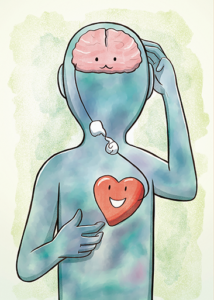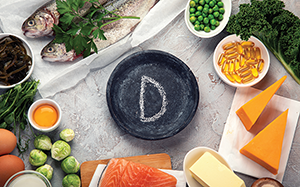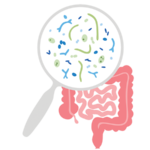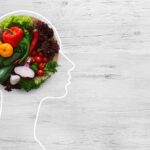
Researchers at the University of Georgia have shown that eating foods with high levels of lutein and zeaxanthin, such as dark leafy greens and yellow and orange vegetables, improves visual range, or the ability to see an object clearly from a distance. Blue light can affect our vision, making objects appear fuzzier and harder to see over far distances. Diets high in lutein and zeaxanthin can help prevent blue light from entering the eye, thus improving visual range; lutein and zeaxanthin can also lower glare disability and increase visual-motor reaction time, all of which are particularly beneficial to athletes.
Source: ScienceDaily. Colorful fresh foods improve athletes’ vision. 8 Jun 2023. https://www.sciencedaily.com/releases/2023/06/230608120930.htm. Accessed 13 Jul 2023.

Lecanemab has recently been granted traditional full approved by the United States (US) Food and Drug Administration (FDA) for the treatment of early-stage Alzheimer’s disease. With this approval, the Centers for Medicare and Medicaid Services announced that it would expand coverage of the drug, making it more affordable for patients. In January 2023, lecanemab was granted accelerated approval by the FDA based on evidence that it clears amyloid plaque buildups associated with Alzheimer’s disease. Results from an 18-month clinical trial showed that lecanemab slowed declines in cognitive ability and function by 27 percent.
Source: Tirrell M, Kounang N, Luhby T. First Alzheimer’s drug to slow disease progression gets full FDA approval, triggering broader Medicare coverage. CNN Health. 6 Jul 2023. https://www.cnn.com/2023/07/06/health/leqembi-alzheimers-fda-approval-medicare/index.html. Accessed 13 Jul 2023.
A diet high in omega-3 fatty acids could potentially slow disease progression in patients with amyotrophic lateral sclerosis (ALS). Researchers followed 449 patients with ALS over 18 months, monitoring levels of omgea-3 fatty acids in the blood. Patients with the highest amount of alpha-linolenic acid (ALA), which can be found in walnuts, flaxseeds, chia seeds, and vegetable oils, had better functioning and less severe symptoms at baseline, compared to those with the lowest amount.
Source: ScienceDaily. Omega-3 fatty acids linked to slower decline in ALS. 21 Jun 2023. https://www.sciencedaily.com/releases/2023/06/230621164636.htm. Accessed 13 Jul 2023.
 Study explores the role of diet in supporting a healthy gastrointestinal microbiota
Study explores the role of diet in supporting a healthy gastrointestinal microbiotaRecent research suggests that following the Dietary Guidelines for Americans (DGA) promotes a gut microbiota that positively impacts overall health. Having a diverse gut microbiota helps protect against disease. Among 432 individuals who participated in the study, those with the best adherence to the DGA had the most diverse gut microbiota and a larger abundance of bacteria known to play a role in beneficial bodily functions, such as fiber fermentation.
Source: Medical News. Study explores the role of diet in supporting a healthy gastrointestinal microbiota. 5 May 2023. https://www.news-medical.net/news/20230505/Study-explores-the-role-of-diet-in-supporting-a-healthy-gastrointestinal-microbiota.aspx. Accessed 9 May 2023.
 Mental wellness is important for a healthy heart and brain
Mental wellness is important for a healthy heart and brainAnxiety, depression, and stress could potentially increase the risk of heart disease and stroke, according to research from the American Heart Association (AHA). The body can react to negative psychological health through irregular heart rate, increased blood pressure, and increased inflammation, explains Michelle A. Albert, MD, MPH, FAHA. Furthermore, negative psychological health is associated with smoking, lower physical activity levels, unhealthy diet, and other factors that can increase the risk of heart disease and stroke. Tips to improve mental wellbeing include meditation, adequate sleep, regular exercise, and staying connected to family and friends.
Source: American Heart Association. Mental wellness is important for a healthy heart and brain. 5 May 2023. https://newsroom.heart.org/news/mental-wellness-is-important-for-a-healthy-heart-and-brain. Accessed 9 May 2023.
 It’s Not Them, It’s You: Potatoes Don’t Deserve Their Bad Reputation
It’s Not Them, It’s You: Potatoes Don’t Deserve Their Bad ReputationResearch has shown that health issues associated with potatoes may actually be due to how people are preparing them and what they’re eating them with.
Read more here: https://www.sciencedaily.com/releases/2022/12/221205104240.htm
 Post-Workout Protein: Separating Fact from Fiction
Post-Workout Protein: Separating Fact from FictionYou may have read or heard that muscles are more receptive to protein uptake immediately after a workout; however, research has not supported that theory. Rather, various studies are showing that muscles are more receptive to protein intake at one, two, and three hours following a workout, and benefits might extend up to 24 hours after exercising. Eating an adequate amount of protein is important for building and repairing muscle fibers, especially after a tough workout. But more isn’t necessarily better—the muscles can only absorb about 15 to 30g at a time, so no need to overdo it on protein consumption after a workout.
Source: Fetters KX, Howley EK. Post-workout protein: separating fact from fiction. US News. 5 May 2023. https://health.usnews.com/wellness/fitness/articles/do-you-really-need-protein-right-after-your-workout. Accessed 8 May 2023.
A new study in the Journal of the Academy of Nutrition and Dietetics has determined that 60% of foods purchased by Americans contain technical food additives, including coloring or flavoring agents, preservatives, and sweeteners. This represents a 10% increase since 2001. The findings also present compelling evidence that the prevalence of food additives is on the rise; manufacturers have increased the mean number of additives contained in purchased food and beverage products from 3.7 in 2001 to 4.5 in 2019. While food additives can extend shelf life and improve palatability, their health consequences are not fully understood.
Read the full study here: https://www.jandonline.org/article/S2212-2672(22)01193-5/fulltext.
March is National Nutrition Month®, and the Academy of Nutrition and Dietetics offers the following advice on food storage:
• Don’t store eggs on the refrigerator door because it’s the warmest part of the refrigerator. Instead, store eggs in the center of the refrigerator and store condiments on the door.
• Store milk in the back bottom of the refrigerator where it’s the coldest, and store packaged raw or frozen meats on the bottom shelf to reduce the chances of juices dripping onto other foods.
• Apples, unripe bananas, and cantaloupe all emit ethylene gas, so keep them away from other produce to avoid them over-ripening their neighbors.
• Additional ethylene producers are avocados, figs, nectarines, pears, peaches and tomatoes.
• Vegetables like cauliflower, broccoli, and cabbage are also sensitive to ethylene and will stay fresher when stored away from ethylene producers, such as kiwis and plums.
• Additional ethylene-sensitive foods are carrots, cucumbers, leafy greens and squash.
• Store onions and potatoes separately and outside of the refrigerator in a dark, cool, dry and well-ventilated space.
Access free resources and fun activities promoting healthy eating at the Academy of Nutrition and Dietetics website https://www.eatright.org/national-nutrition-month-2023/resources
 Female sex and autoimmune disorders
Female sex and autoimmune disordersApproximately 80 percent of all people who have an autoimmune disorder are biologically female. In the article, “The Prevalence of Autoimmune Disorders in Women: A Narrative Review,” by Angum et al, researchers state the following:
“Men and women alike are born with 23 pairs of chromosomes, with 22 pairs of autosomes and one pair of sex chromosomes, the differentiating factor between the two genders. Women have XX sex chromosomes, while men have XY sex chromosomes. The X and Y sex chromosomes vary greatly in size as the X chromosome is physically larger than the Y chromosome. This disproportion between the two chromosomes suggests that the X chromosome contains more genes than the Y chromosome. The X chromosomes contain approximately 800-900 genes coded to provide instructions for proteins, entailing for 5% of total DNA in human cells, whereas, the Y chromosomes contain approximately 50-60 genes coded to provide instructions for proteins and this entails about 2% of total DNA in human cells. Furthermore, the X chromosome also stains for a greater amount of immune-related genes as well as immune regulatory genes, which aids and induces immunological responses in the body. The larger number of genes originating from the X chromosome creates a far greater possibility of a larger number of mutations occurring. This puts women at a greater risk for the development of autoimmune diseases solely due to women having two X chromosomes, whereas men possess only one. The presence of two X chromosomes essentially creates a “double dose” of genes present on the X chromosome and because of this, predisposes the female to autoimmunity.”
SOURCE: Angum F, Khan T, Kaler J, et al. The prevalence of autoimmune disorders in women: a narrative review. Cureus. 2020 May; 12(5): e8094.
 Taking vitamin D could help prevent dementia
Taking vitamin D could help prevent dementiaIn a prospective cohort study, investigators assessed the effects of Vitamin D on dementia incidence in 12,388 participants from the National Alzheimer’s Coordinating Center dataset. They found that vitamin D exposure was associated with 40% lower dementia incidence versus no exposure. Vitamin D effects were significantly greater in female participants than in male participants and in normal cognition versus mild cognitive impairment. Vitamin D effects were significantly greater in apolipoprotein E ε4 non-carriers versus carriers. The authors concluded that vitamin D has potential for dementia prevention, especially in the high-risk strata.
SOURCE: Ghahremani M, Smith EE, Chen HY, et al. Vitamin D supplementation and incident dementia: effects of sex, APOE , and baseline cognitive status. Alzheimer’s & Dementia: Diagnosis, Assessment & Disease Monitoring. 2023;15(1). https://alz-journals.onlinelibrary.wiley.com/doi/10.1002/dad2.12404.
 Mediterranean diet associated with decreased risk of dementia
Mediterranean diet associated with decreased risk of dementiaEating a traditional Mediterranean-type diet—rich in foods such as seafood, fruit, and nuts—may help reduce the risk of dementia by almost a quarter, a new study has revealed. Using a Cox proportional hazard regression models to explore the associations between Mediterranean diet adherence and incident all-cause dementia risk in 60,298 participants from UK Biobank. Participants were followed for an average 9.1 years. The interaction between diet and polygenic risk for dementia was also tested. The investigators found that higher adherence to the Mediterranean diet was associated with lower dementia risk. The researchers concluded that higher adherence to a Mediterranean diet was associated with lower dementia risk, independent of genetic risk, underlining the importance of diet in dementia prevention interventions.
Source: Shannon OM, Ranson JM, Gregory S, et al. Mediterranean diet adherence is associated with lower dementia risk, independent of genetic predisposition: findings from the UK Biobank prospective cohort study. BMC Med. 2023;21(81) https://doi.org/10.1186/s12916-023-02772-3.
The ready-to-eat packaged meals—known as Lunchables, which are sold at grocery stores and have sustained generations of American schoolchildren—are set to be served directly to students at school lunch programs beginning in the fall. But Heinz, the Pittsburgh-based company that manufactures them, first had to change their ingredients to satisfy federal nutrition regulations. Kraft Heinz executive vice-president Carlos Abrams-Rivera said the company has produced two new varieties of specially formulated Lunchables containing “improved nutrition” so that they can become part of the National School Lunch program, which provides lunch daily to nearly 30 million students across the US. The new Lunchables rollout comes amid changes issued by the US department of agriculture to school food programs aimed at reducing sugars and sodium levels. Schools are required to offer meals that contain five meal components – fruit, vegetable, protein, grain and milk. Under new proposals, schools are encouraged to use more locally grown food. The USDA has said it plans to invest $100m in a Healthy Meals Incentives initiative offering farm-to-school grants and the replacement of kitchen equipment put out in the 1980s as schools moved to prepackaged processed food. The changes comes as rates of childhood obesity have become a “serious problem”, according to the US Centers for Disease Control and Prevention. The agency recorded obesity – often linked to high blood pressure, high cholesterol, type 2 diabetes, breathing issues and joint problems – prevalent in almost 20% of children and adolescents between the ages of 2 and 19 from 2017 through 2019.
SOURCE: The Guardian website. Lunchables with ‘improved nutrition’ to be part of US school lunch programs. 14 Mar 2023. https://www.theguardian.com/us-news/2023/mar/14/lunchables-school-lunch-programs. Accessed 17 Mar 2023.
Anew study of over 19,000 adults found a 15% higher likelihood of diabetes or history of stroke or heart disease among Americans restricting carbohydrates to less than 45% of energy compared with those eating a diet balanced in carbohydrate, fat, and protein. The risk was even higher (40%) among those eating a carbohydrate-restricted diet that was also high in fat. The study, titled “Fat Intake Modifies the Association between Restricted Carbohydrate Diets and Prevalent Cardiometabolic Diseases among Adults in the United States: National Health and Nutrition Examination Survey, 1999–2018,” appeared in the January 2023 issue of Current Developments in Nutrition. Access the study here: https://www.sciencedirect.com/science/article/pii/S2475299122145191.
 A new tool in the arsenal against COVID-19 is being put to the test
A new tool in the arsenal against COVID-19 is being put to the testResearchers have uncovered a class of severe acute respiratory syndrome coronavirus 2 (SARS-CoV-2) antibodies that can bind to a spike protein on the virus that would be hard to mutate. Through this mechanism, these antibodies can neutralize different variants of COVID-19. This discovery could result in antibody therapies to treat and prevent multiple variants of COVID-19.
Source: ScienceDaily. A new tool in the arsenal against COVID-19 is being put to the test. 14 Feb 2023. https://www.sciencedaily.com/releases/2023/02/230214154032.htm Accessed 20 Mar 2023.
 Hormone replacement therapy could ward off Alzheimer’s among at-risk women
Hormone replacement therapy could ward off Alzheimer’s among at-risk womenResearchers have found that hormone replacement therapy (HRT) use in female individuals with the APOE4 gene, the strongest risk factor gene for Alzheimer’s disease, was linked to larger brain volume, better memory, and better cognition. HRT was most effective when introduced during perimenopause. Thus, HRT shows promise as a potential treatment option for Alzheimer’s disease, although more studies must be done to elucidate these findings.
Source: ScienceDaily. HRT could ward off Alzheimer’s among at-risk women. 14 Jan 2023. https://www.sciencedaily.com/releases/2023/01/230114142747.htm Accessed 20 Mar 2023.
 Body dissatisfaction can lead to eating disorders at any age
Body dissatisfaction can lead to eating disorders at any ageJanuary 29, 2023—Research from the North American Menopause Society (NAMS) identified dissatisfaction with body image as a prevalent risk factor for eating disorders in women at midlife. Dr. Stephanie Faubion, Medical Director, NAMS, noted that fear of losing control when eating and fear of gaining weight were core features of disordered eating behavior among peri- and early postmenopausal individuals.
Source: Science Daily. Body dissatisfaction can lead to eating disorders at any age. 18 Jan 2023. https://www.sciencedaily.com/releases/2023/ 01/230118092038.htm. Accessed 29 Jan 2023.
 Rx for prolonged sitting: a five-minute stroll every half hour
Rx for prolonged sitting: a five-minute stroll every half hourJanuary 12, 2023—A study at Columbia University examined the effects of different walking regimens on individuals sitting for eight hours per day. Walking for five minutes for every 30 minutes of sitting can significantly lower blood sugar and blood pressure; this routine also led to a 58-percent reduction in blood sugar spike after large meals, compared to sitting for eight hours with no walking. A one-minute walking break every 30 minutes provided modest reductions in blood sugar, whereas one- and five-minute walking breaks every 60 minutes appeared to have no beneficial effect on blood sugar. However, all walking breaks led to decreases in blood pressure of 4 to 5mmHg, compared to no walking.
Source: Science Daily. Rx for prolonged sitting: a five-minute stroll every half hour. 12 Jan 2023. https://www.sciencedaily.com/releases/2023/01/230110103508.htm. Accessed 18 Jan 2023.

January 9, 2023—Using data from 75,230 women and 44,085 men, researchers found that higher scores, indicating greater adherence to the diet, for at least one of four dietary indices (Healthy Eating Index 2015, Alternate Mediterranean Diet, Healthful Plant-based Diet Index, and Alternate Healthy Eating Index), was associated with lower risk of premature death of all causes, as well as cancer, cardiovascular disease, and respiratory disease. Furthermore, higher scores for the Alternative Mediterranean Diet and Alternative Healthy Eating Index were correlated with lower risk of death due to neurodegenerative disease.
Source: Science Daily. Variety of healthy eating patterns linked with lower risk of premature death. 9 Jan 2023. https://www.sciencedaily.com/releases/2023/01/230109112708.htm. Accessed 18 Jan 2023.
 Fewer cases of melanoma among people taking vitamin D supplements
Fewer cases of melanoma among people taking vitamin D supplementsJanuary 9, 2023—Recent research shows that people with an increased risk of skin cancer who regularly took vitamin D supplements had a reduced risk of melanoma, compared to those who did not take vitamin D. Furthermore, vitamin D users tended to have better skin cancer risk classification than nonusers.
Source: Science Daily. Fewer cases of melanoma among people taking vitamin D supplements. 9 Jan 2023. https://www.sciencedaily.com/releases/2023/01/230109112555.htm. Accessed 18 Jan 2023.
 NIH-funded study shows sound sleep supports immune function
NIH-funded study shows sound sleep supports immune functionGetting a consistent good night’s sleep supports normal production and programming of hematopoietic stem cells, a building block of the body’s innate immune system, according to a small National Institutes of Health-supported study in humans and mice. Sleep has long been linked to immune function, but researchers discovered that getting enough of it influenced the environment where monocytes—a type of white blood cell—form, develop, and get primed to support immune function. This process, termed hematopoiesis, occurs in the bone marrow. The study was published in the Journal of Experimental Medicine.
To assess these mechanisms, researchers studied associations between sleep and monocyte production in humans and mice, which expanded on findings from prior mathematical models. They analyzed how sleep disruptions increased circulating levels of these immune cells and changed the environment in the bone marrow
In a collaborative study led by Marie-Pierre St-Onge, PhD, at Columbia University, New York City, 14 adults enrolled in the clinical research trial. They each participated in a six-week study arm that emulated getting enough sleep (about 7.5 hours each night) or that created sleep deficiency. To model sleep restriction, adults reduced their nighttime sleep by 1.5 hour— getting about six hours of sleep each night. Sleep conditions were separated by a six-week “washout” period, during which participants returned to their normal sleep patterns.
Morning and afternoon blood samples were collected during the fifth and sixth weeks for each sleep condition. Researchers found that when adults didn’t get enough sleep, they had higher levels of circulating monocytes in the afternoon. They also had higher numbers of immune stem cells in the blood and evidence of immune activation.
A higher production of immune cells creates a more homogenous immune environment, which can accelerate clonal hematopoiesis, an age-related condition that has been linked to increased risks for cardiovascular disease.
Prior studies have identified genetic mutations that drive the proliferation of hematopoietic stem cells. However, this study found that putting pressure on the hematopoietic system, in this case through sleep restriction, produced similar results without the driver mutations.
The study authors said their findings also underscored the importance of establishing sound sleep patterns early in life, which may reduce the severity of other inflammatory conditions such as sepsis. Most adults should get 7 to 8 hours of uninterrupted sleep each night. Older adults need about 7 to 9 hours, while children ages 11 to 17 years need about 8 to 10 hours.
The study was partially funded by NHLBI and the National Center for Advancing Translational Sciences.
Source: McAlpine CS, Kiss MG, Zuraikat FM, et al. Sleep exerts lasting effects on hematopoietic stem cell function and diversity. J Exp Med. 2022
 Dr. Fauci reflects on the perpetual challenge of infectious diseases
Dr. Fauci reflects on the perpetual challenge of infectious diseasesOnce considered a potentially static field of medicine, the discipline of studying infectious diseases has proven to be dynamic as emerging and reemerging infectious diseases present continuous challenges, Anthony S. Fauci, MD, writes in a perspective in the New England Journal of Medicine. In the piece, Dr. Fauci, who since 1984 has directed the National Institute of Allergy and Infectious Diseases (NIAID), part of the National Institutes of Health, reflects on his career responding to infectious disease threats. Dr. Fauci stepped down from his positions as NIAID director, chief of NIAID’s Laboratory of Immunoregulation, and chief medical advisor to President Joe Biden in December 2022.
In the perspective, Dr. Fauci notes that the emergence of HIV/AIDS in 1981 led to a sharp increase in interest in infectious diseases among people entering the field of medicine. Since then, infectious disease specialists have faced numerous medical challenges, including the 2009 H1N1 influenza pandemic, Ebola, Zika, severe acute respiratory syndrome (SARS), Middle East respiratory syndrome (MERS) and COVID-19, he writes.
Although COVID-19 was “the loudest wake-up call in more than a century to our vulnerability to outbreaks of emerging infectious diseases,” Dr. Fauci notes that one success of the response was the rapid development, testing, and distribution of COVID-19 vaccines, thanks to years of research and investment in new and highly adaptable vaccine platforms and structural biology tools to design vaccine immunogens. These technological advances, among others, will greatly benefit the field of infectious diseases, he writes. He concludes by stressing the importance of improving capabilities to respond to established infectious diseases, such as malaria and tuberculosis, while also responding to emerging threats.
Source: Fauci AS. It ain’t over till it’s over…but it’s never over—emerging and reemerging infectious diseases. N Engl J Med. 2022; 387:2009–2011.
 Study challenges “good” cholesterol’s role in universally predicting heart disease risk
Study challenges “good” cholesterol’s role in universally predicting heart disease riskA National Institutes of Health-supported study found that high-density lipoprotein (HDL) cholesterol, often called the “good cholesterol,” may not be as effective as scientists once believed in uniformly predicting cardiovascular disease risk among adults of different racial and ethnic backgrounds. The research, which was published in the Journal of the American College of Cardiology, found that while low levels of HDL cholesterol predicted an increased risk of heart attacks or related deaths for White adults—a long-accepted association—the same was not true for Black adults. Additionally, higher HDL cholesterol levels were not associated with reduced cardiovascular disease risk for either group. Investigators reviewed data from 23,901 United States adults who participated in the Reasons for Geographic and Racial Differences in Stroke Study (REGARDS). Previous studies that shaped perceptions about “good” cholesterol levels and heart health were conducted in the 1970s, with the majority of participants being White adults. For the current study, researchers were able to look at how cholesterol levels from Black and White middle-aged adults without heart disease who lived throughout the country overlapped with future cardiovascular events. The authors conclude that in addition to supporting ongoing and future research with diverse populations to explore these connections, the findings suggest that cardiovascular disease risk calculators using HDL cholesterol could lead to inaccurate predictions for Black adults.
Source: Zakai NA, Minnier J, Safford MM, et al. Race-dependent association of high-density lipoprotein cholesterol levels with incident coronary artery disease. J Am Coll Cardiol. 2022;80(22):2104–2115.
 Twin study links exercise to beneficial epigenetic changes
Twin study links exercise to beneficial epigenetic changesDecember 6, 2022—Consistent exercise can change not just waistlines but the very molecules in the human body that influence how genes behave, a new study of twins indicates. Researchers from Washington State University found that the more physically active siblings in identical twin pairs had lower signs of metabolic disease, measured by waist size and body mass index. This also correlated with differences in their epigenomes, the molecular processes that are around DNA and independent of DNA sequence, but influence gene expression. The more active twins had epigenetic marks linked to lowered metabolic syndrome, a condition that can lead to heart disease, stroke, and Type 2 diabetes. Since the identical twins have the same genetics, the study suggests that markers of metabolic disease are strongly influenced by how a person interacts with their environment as opposed to just their inherited genetics.
Source: Washington State University. Twin study links exercise to beneficial epigenetic changes. ScienceDaily. www.sciencedaily.com/releases/2022/12/221206083112.htm. Accessed 8 Dec 2022).
 Peanuts, Herbs, and Spices May Positively Impact Gut Microbiome
Peanuts, Herbs, and Spices May Positively Impact Gut MicrobiomeDecember 1, 2022—A diverse gut microbiome is associated with improved health. According to two new studies from Penn State, adding peanuts, herbs, and spices to your diet can increase gut microbiome diversity. One study showed that eating about one ounce of peanuts per day resulted in increased levels of Ruminococcaceae, which is associated with healthy liver metabolism and immune function. In another study, adding up to 1.5tsp of herbs and spices (e.g., cinnamon, ginger, basil, thyme) per day to participants’ diets led to an increase in gut microbiome diversity, including Ruminococcaceae.
Source: Penn State. Peanuts and herbs and spices may positively impact gut microbiome” ScienceDaily. www.sciencedaily.com/releases/2022/12/221201203929.htm. Accessed December 6, 2022.
 Low-calorie sweetener does not seem to increase cancer risk in US adults
Low-calorie sweetener does not seem to increase cancer risk in US adultsNovember 22, 2022—In a recent study published in the journal, Nutrients, researchers found that there was no association between low-calorie sweetener consumption and increased risk of cancer-related mortality. However, low-calorie sweetener use was linked to a higher prevalence of diabetes and obesity. The authors also noted that individuals who consumed low-calorie sweeteners were more likely to consume significantly less added sugars and alcohol and significantly more dietary fiber. Female and non-Hispanic White individuals, nonsmokers, and individuals with higher income and educational backgrounds were more likely to consume low-calorie sweeteners.
Source: Fulgoni VL. (2022). No association between low-calorie sweetener (LCS) use and overall cancer risk in the nationally representative database in the US: analyses of NHANES 1988–2018 data and 2019 public-use linked mortality files. Nutrients. 2022 Nov 22;14(23):4957.
 Exercise Can Reduce Severity of Breast Cancer Treatment Side Effects
Exercise Can Reduce Severity of Breast Cancer Treatment Side EffectsNovember 21, 2022—Radiotherapy has emerged as an important component of breast cancer treatment but can lead to cancer-related fatigue and negatively impact a person’s health-related quality of life. Research indicates that exercise may make the treatment more tolerable for patients. Investigators from Edith Cowan University in West Australia recruited 106 women undergoing radiotherapy treatment for breast cancer to participate in the study—the women were randomized to 12 weeks of home-based resistance and aerobic exercise plus standard care or standard care alone. Eighty-nine women completed the study—43 in the exercise+standard care group and 46 in the standard care alone. The 12-week exercise program consisted of a weekly exercise regimen of 1 to 2 resistance training sessions and an accumulated 30 to 40 minutes of aerobic exercise. Compared to controls, the women in the exercise group improved more quickly from cancer-related fatigue during and after radiotherapy. Additionally, after radiotherapy treatment, the women in the exercise group showed greater improvements in health-related quality of life measures than those in the standard care alone group. Improvements were seen even in the women who did smaller dosages of the prescribed exercise regimen.
Source: Edith Cowan University. Exercise can reduce severity of breast cancer treatment side effects” ScienceDaily. www.sciencedaily.com/releases/2022/11/221121105225.htm Accessed December 6, 2022.
 FAST FACTS: How New Flu Vaccines Are Made Each Year
FAST FACTS: How New Flu Vaccines Are Made Each YearNovember 3, 2022—Twice a year, WHO directors and scientists representing countries from around the world meet to review surveillance, laboratory, and clinical study data and make recommendations on the composition of flu vaccines for the following flu season. The most common way flu vaccines are made in the United States is using an egg-based manufacturing process, in which candidate viruses, based on WHO recommendations, are grown in chicken eggs, extracted, and A) inactivated (killed) and antigen-purified to make inactivated virus flu shots or B) weakened (but not killed) to make live attenuated virus nasal vaccines. There also is a cell culture-based production process for vaccines that was approved by FDA in 2012, which is used to make inactivated virus flu shots, and, more recently, an FDA-approved recombinant DNA production process, which creates synthetic vaccines.
SOURCE: US Centers for Disease Control and Prevention website. How influenza (flu) vaccine are made. 3 Nov 2022. https://www.cdc.gov/flu/prevent/how-fluvaccine-made.htm. Accessed 9 Dec 2022.
 Statistical Oversight Could Explain Inconsistencies in Nutritional Research
Statistical Oversight Could Explain Inconsistencies in Nutritional ResearchOctober 13, 2022—People often wonder why one nutritional study tells them that eating too many eggs, for instance, will lead to heart disease and another tells them the opposite. The answer to this and other conflicting food studies may lie in the use of statistics, according to a report published recently in the American Journal of Clinical Nutrition. The researchers found that the widespread practice of statistically controlling, or allowing for, someone’s total energy intake can lead to dramatic changes in the interpretation of the results. Controlling for other foods eaten can then further skew the results, so that a harmful food appears beneficial or vice versa. For full story, visit: ScienceDaily. www.sciencedaily.com/releases/2022/10/221013084109.htm Accessed December 8, 2022).

September 26, 2022—The United States (US) Food and Drug Administration (FDA) plans to propose a measure to add nutrition labels to the front of food packages in the form of star ratings or traffic light imaging. The goal is to help consumers, especially those with low nutritional literacy, make healthy food choices.
Source: Richards Z. Biden admin to propose nutrition labels on front of food packaging in push to improve health. NBC News. 27 Sep 2022. https://www.nbcnews.com/politics/white-house/biden-administration-propose-nutrition-labels-front-food-packaging-pus-rcna49529. Accessed 30 Sep 2022.
 September 26, 2022—In a recent study published in the European Journal of Preventive Cardiology, researchers observed that drinking 2 to 3 cups of instant, ground, or decaffeinated coffee per day was associated with decreased risk of death from any cause and incident cardiovascular disease, compared to not drinking coffee. Additionally, drinking ground and instant coffee was linked to a lower risk of arrhythmia.
September 26, 2022—In a recent study published in the European Journal of Preventive Cardiology, researchers observed that drinking 2 to 3 cups of instant, ground, or decaffeinated coffee per day was associated with decreased risk of death from any cause and incident cardiovascular disease, compared to not drinking coffee. Additionally, drinking ground and instant coffee was linked to a lower risk of arrhythmia.
Source: Science Daily. Coffee drinking is associated with increased longevity. 26 Sep 2022. https://www.sciencedaily.com/releases/2022/09/220926200838.htm. Accessed 30 Sep 2022.
July 5, 2022—Laughter yoga combines stretching-relaxation techniques, deep breathing, and laughter and is best practiced in a group. In this study, the authors assessed the effects of laughter yoga on perceived stress, burnout, and life satisfaction in nurses during the COVID-19 pandemic. Nurses who practiced laughter yoga reported improvements in perceived stress and decreased feelings of depersonalization, emotional exhaustion, and burnout. They also experienced increased personal success and life satisfaction, compared to nurses who did not participate in laughter yoga.
SOURCE: Sis Çelik A, Kılınç T. The effect of laughter yoga on perceived stress, burnout, and life satisfaction in nurses during the pandemic: a randomized controlled trial. Complement Ther Clin Pract. 2022;49:101637. DOI: 10.1016/j.ctcp.2022.101637.
 Women urged to eat potassium-rich foods to improve their heart health
Women urged to eat potassium-rich foods to improve their heart healthJune 22, 2022—According to a study published recently in European Heart Journal, a journal of the European Society of Cardiology (ESC), potassium-rich diets may help lower blood pressure, particularly in women with high salt intake. The study included 24,963 participants (11,267 men and 13,696 women) of the EPIC-Norfolk study, which recruited 40- to 79-year olds from general practices in Norfolk, United Kingdom, between 1993 and 1997. Participants completed a questionnaire on lifestyle habits, blood pressure was measured, and a urine sample was collected. Urinary sodium and potassium levels were used to estimate dietary intake. Participants were divided into groups according to sodium intake (low/medium/high) and potassium intake (low/medium/high).
The researchers analyzed the association between potassium intake and blood pressure after adjusting for age, sex and sodium intake. Potassium consumption (in grams per day) was associated with blood pressure in women—as intake went up, blood pressure went down. When the association was analyzed according to sodium intake (low/medium/high), the relationship between potassium and blood pressure was only observed in women with high sodium intake, where every one-gram increase in daily potassium was associated with a 2.4mmHg lower systolic blood pressure. In men, there was no association between potassium and blood pressure.
During a median follow-up of 19.5 years, 13,596 (55%) participants were hospitalized or died due to cardiovascular disease. The researchers analyzed the association between potassium intake and cardiovascular events after adjusting for age, sex, body mass index, sodium intake, use of lipid-lowering drugs, smoking, alcohol intake, diabetes, and prior heart attack or stroke. Overall, people in the group with highest potassium intake had a 13-percent lower risk of cardiovascular events compared to those in the lowest potassium intake group. When men and women were analyzed separately, the corresponding risk reductions were seven percent and 11 percent, respectively. The amount of salt in the diet did not influence the relationship between potassium and cardiovascular events in men or women.
The World Health Organization recommends that adults consume at least 3.5 grams of potassium and less than 2 grams of sodium (5 grams of salt) per day. High potassium foods include vegetables, fruit, nuts, beans, dairy products, and fish.
Source: Wouda RD, Boekholdt SM, Khaw KT, et al. Sex-specific associations between potassium intake, blood pressure, and cardiovascular outcomes: the EPIC-Norfolk study. Eur Heart J. 2022. doi:10.1093/eurheartj/ehac313
 Most people think their diet is healthier than it is
Most people think their diet is healthier than it isJune 14, 2022—How healthy is your diet? It seems like a simple question, but according to a new study, it’s one that most Americans struggle to get right.
“We found that only a small percentage of U.S. adults can accurately assess the healthfulness of their diet, and interestingly, it’s mostly those who perceive their diet as poor who are able to accurately assess their diet,” said Jessica Thomson, PhD, research epidemiologist with the U.S. Department of Agriculture’s Agricultural Research Service in the Southeast Area, the study’s lead author. “Additionally, most adults overrate the quality of their diet, sometimes to a substantial degree.”
The researchers wanted to find out whether a single, simple question could be used as a screening tool for nutrition studies—to replace or complement the detailed dietary questionnaires commonly used in nutrition research. Previous studies have found that self-rated health is a strong predictor of morbidity and mortality, but there is scant research on whether self-rated diet quality is predictive of the actual quality of one’s diet.
The study used data from the National Health and Nutrition Examination Survey, a nationally representative survey of U.S. adults conducted every two years. Participants were asked to complete detailed 24-hour dietary recall questionnaires and rate their diet as excellent, very good, good, fair or poor.
Researchers used the food recall questionnaires to score each participant’s diet quality. Examples of foods ranked as healthier include fruits and vegetables, whole grains, healthy fats, lower-fat dairy products, seafood and plant proteins. Foods considered less healthy included refined grains and foods high in sodium, added sugars or saturated fats.
The study revealed significant disconnects between the researcher-calculated scores and how participants ranked their own diet. Out of over 9,700 participants, about 8,000 (roughly 85%) inaccurately assessed their diet quality. Of those, almost all (99%) overrated the healthfulness of their diet.
Surprisingly, accuracy was highest among those who rated their diet as poor, among whom the researcher’s score matched the participant’s rating 98 percent of the time. The proportion of participants who accurately assessed their diet quality ranged from 1 to 18 percent in the other four rating categories.
Thomson said further research could help to elucidate what factors people consider when asked to assess their diet quality. For instance, it would be helpful to know whether people are aware of particular dietary recommendations and whether they take into consideration where their food is purchased or how it is prepared.
Source: American Society for Nutrition. Most people think their diet is healthier than it is. 14 Jun 2022. https://nutrition.org/most-people-think-their-diet-is-healthier-than-it-is/. Accessed 16 Aug 2022.
 Cranberries Good for Improving Memory and Preventing Dementia
Cranberries Good for Improving Memory and Preventing Dementia19 May 2022—Researchers from the University of East Anglia (UK) studied the effects of consuming the equivalent of one cup of cranberries a day for 12 weeks on brain function and cholesterol in 60 cognitively healthy adults, aged 50 to 80 years old. Participants who consumed the dried cranberry powder experienced improved memory, neural functioning, and delivery of blood to the brain, as well as a significant decrease in LDL or ‘bad’ cholesterol levels, compared to the control group.
SOURCE: Flanagan E et al. Chronic consumption of cranberries (Vaccinium macrocarpon) for 12 weeks improves episodic memory and regional brain perfusion in healthy older adults: a randomised, placebo-controlled, parallel-groups feasibility study. Front Nutrition. 2022;9

10 May 2022—Researchers from Ohio State University surveyed parents of 134 kids with ADHD on the typical foods their children ate over a 3-month period, including portion sizes. In separate survey, the researchers asked parents to rate symptoms of inattention in their kids. Results showed that kids who consumed more fruits and vegetables showed less severe symptoms of inattention. The researchers postulate that low levels of some neurotransmitters in the brain may result in ADHD and that getting the proper amount of vitamins and minerals can help the body produce those neurotransmitters and improve overall brain function.
SOURCE: Robinette LM, Hatsu IE, Johnstone JM, et al. Fruit and vegetable intake is inversely associated with severity of inattention in a pediatric population with ADHD symptoms: the MADDY Study. Nutritional Neuroscience. 2022;1 DOI:http://10.1080/1028415X.2022.2071805
 Being in Nature: Good for Mind, Body, and Nutrition
Being in Nature: Good for Mind, Body, and Nutrition5 Apr 2022—Researchers investigated how nature relatedness—simply feeling connected with the natural world—benefits dietary diversity and fruit and vegetable intake. Researchers surveyed over 300 adults in Philadelphia to measure their self-reported connection to nature, including their experience with and perspective of nature, and the foods and beverages they had consumed the previous day, to assess their dietary diversity and estimate their daily fruit and vegetable consumption. The study was conducted from May to August 2017. According to survey results, participants who reported having a stronger connection to nature also reported a more varied diet and ate more fruits and vegetables.
SOURCE: Milliron BJ, et al. Nature relatedness is positively associated with dietary diversity and fruit and vegetable intake in an urban population. Am J Health Promotion. 2022
 Research Shows Healthy Home Cooking Equals a Healthy Mind
Research Shows Healthy Home Cooking Equals a Healthy Mind21 Mar 2022—New research has found being confident in the kitchen is not only good for your taste buds: it’s also good for your mental health. Results of the study suggest suggests a link between cooking confidence and satisfaction around cooking, and mental health benefits.
SOURCE: Edith Cowan University. “Chef’s kiss: Research shows healthy home cooking equals a healthy mind: New research has found being confident in the kitchen is not only good for your taste buds: it’s also good for your mental health.” ScienceDaily. ScienceDaily, 21 March 2022. www.sciencedaily.com/releases/2022/03/220321091919.htm.
 Large Study Challenges the Theory that Light Alcohol Consumption Benefits Heart Health
Large Study Challenges the Theory that Light Alcohol Consumption Benefits Heart Health25 Mar 2022—In an observational analysis of UK Biobank participants, light to moderate drinkers had the lowest heart disease risk, followed by people who abstained from drinking; however, light to moderate drinkers tended to have healthier lifestyles than abstainers, which likely accounted for their better heart health. Genetic evidence in this same population suggested that all levels of alcohol intake are associated with increased cardiovascular risk. Notably, the risk of cardiovascular disease linked to light alcohol consumption was modest but rose exponentially with higher intake, even at intake levels currently endorsed as ‘low risk.’
 Nutritional profile of non-dairy plant-based cheese alternatives
Nutritional profile of non-dairy plant-based cheese alternativesMarch 16, 2022—Researchers aimed to determine the nutritional value of 245 plant-based cheese alternatives from a total of 32 brands. The most common cheese alternatives were based on coconut oil with food starch, followed by cashew and coconut oil, and cashews. Twenty-two brands provided no nutritional fortification. Of all the cheese alternatives, 75 percent had 2.5g of protein or less, much less than the 5 to 8g of protein per serving typically found in cheese. Only three percent of all cheese alternatives had at least 5g of protein, all of which were cashew-based. The median calcium and vitamin D contents were zero. Cashew- and almond-based cheese alternatives had the lowest saturated fat content, ranging from 0 to 1g per serving, whereas products containing coconut oil contained 4 to 7g per serving. The authors concluded that when it comes to nutrition, non-dairy plant-based cheese alternatives do not compare to the real thing.
SOURCE: Craig WJ, Mangels AR, Brothers CJ. Nutritional profiles of non-dairy plant-based cheese alternatives. Nutrients. 2022;14(6):1247. DOI: 10.3390/nu14061247.
 Sun protection among American youth
Sun protection among American youthNovember 15, 2021—Researchers conducted a study among US youth aged 14 to 24 years to assess sun protection knowledge. Most respondents acknowledged the importance of sun protection, and 90.1 percent reported using sunscreen; however, 81.1 percent reported having had at least one sunburn in their life, and 28.4 percent reported having had five or more sunburns. A total of 41.1 percent of respondents indicated that education on the consequences of sun exposure would increase sun protection. Respondents indicated that widespread media campaigns, government policies addressing sun protection standards and education, and increased accessibility to sunscreen would result in increased sun protection behaviors.
SOURCE: Strome A, Herbert K, Walsh K, et al. Assessment of sun protection knowledge and behaviors of US youth. JAMA Netw Open. 2021;4(11):e2134550. DOI: 10.1001/jamanetworkopen.2021.34550.

11 Oct 2021—According to a study published last October in Cell Reports Medicine, exercising in cold environments increases activation of brown fat tissue, a type of healthy adipose tissue that can burn fat. Brown fat is also thought to reduce risk of cardiovascular disease. Working out in cold weather also expends more energy.
Source: Søberg S, Löfgren J, Philipsen FE, et al. Altered brown fat thermoregulation and enhanced cold-induced thermogenesis in young, healthy, winter-swimming men. Cells Rep Med. 11 Oct 2021.
 The effect of lifelong exercise frequency on arterial stiffness
The effect of lifelong exercise frequency on arterial stiffness20 May 2018—As a little as two years of consistent aerobic exercise 4 to 5 days a week can have a dramatically positive effect on the health of a previously sedentary middle-aged person’s heart.
SOURCE: Shibata S, Fujimoto N, Hastings JL, et al. The effect of lifelong exercise frequency on arterial stiffness. J Physiol. First published: 20 May 2018
 Atopic Dermatitis (AD)—A Form of Eczema—May Increase Your risk for Some Eye Diseases
Atopic Dermatitis (AD)—A Form of Eczema—May Increase Your risk for Some Eye DiseasesAug 2017—According to a 15-year study in Denmark, the more severe the AD, the higher the risk of developing certain eye diseases. The researchers examined medical records of adults in Denmark and found that those with AD had a higher risk of developing conjunctivitis, also known as pink eye, and keratitis or inflamed cornea. The American Academy of Dermatology warns that individuals with AD should pay close attention to their eyes, and if a problem lasts more than a few days, seek treatment from a dermatologist or ophthalmologist.
Source: Thyssen JP, Toft PB, et al. Incidence, prevalence, and risk of selected ocular disease in adults with atopic dermatitis. J Am Acad Dermatol. 2017;77:280-6.